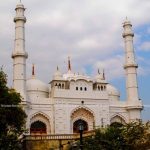Monumental Legacy @ Hazratganj
Exploring the Heritage in and around the busy streets
Lucknow is a city of grand architectural gems ! Few areas are rich of heritage along with scattered monuments also. Hazratganj is one such important area which is filled with numerous monuments. Probably we could have observed and more the chances that we are not aware about the rich list ! Let’s not only confined to the straight stretch from GPO till Stadium; but explore the vicinity around to get the extended list:
Christ Church

The Christ Church is one of the city’s historic church which was designed in 1860 by Hutchinson, a British Army Officer. Built in Gothic style, the Church has a triple storied square tower. The high spire of the tower is topped by a metallic cross. A roomy prayer hall as well as an attractively designed wooden altar makes this church all the more impressive. Gothic arches of the huge windows and doors as well as the appealing railings at the upper most story of the church exemplify the beauty of this edifice. It has memories of the freedom struggle which can be seen today also. It also houses fabulous pieces of art- work and memorial plaques that have names of the English martyrs inscribed on them. It was extended in 1904 and then again in 1916. The Church stands today on the campus of the Christ Church College. This is a much loved landmark of the city. Recent renovation highlighted the beauty of this architectural wonder !
General Post Office (GPO)

Built by the Britishers, the building which is now referred to as GPO, was once a Ring Theatre. It was used by British families for recreational purposes. It was used as a platform for screening English films and English dramas were also played here. A board was permanently hung at the entrance gate bearing the text- ‘Dogs and Indians not allowed!’. Thus, signifying that the entry of Indians inside the building was strictly prohibited. After few years the theatre got converted into a special court where the famous Kakori trial took place. And during the years 1929-1932, the then GPO which was situated inside the Begum Kothi (now known as Janpath) was shifted to this building. One of the flaws in the current state of the historical building is in its clock, which isn’t in a working state as of now. The most outstanding structural feature of this magnificent building is that iron was not at all used in its construction.
Begum Kothi

Immediately on the right commences, a long range of buildings, the whole together known as the Begum Kothi. In the days of the King, these comprised the palace of the Queen mother of Awadh. After the departure of Her Majesty to Europe, in 1856, the buildings remained occupied, strictly as a zenana enclosure, by members of the Queen’s household; but, during the mutiny, the rebels took possession and garrisoned them. On the reoccupation of Lucknow by the British, they each had to be taken by storm. The high wall was leveled, and the several fine buildings, which were hidden from view, have been converted into handsome shops and public offices, also known as Janpath.
Darul Shifa

This house, as its name implies, is a Hospital or Dispensary, which was built by Nawab Sa’adat Ali Khan, and was intended for the reception of the indigent sick, but was never used for that purpose. It is said that some of the ladies of the Awadh Court, having conceived a fancy, obtained possession, and made use of it as a place affording retirement, where they could hold occasional merry-makings in secret. The house has been thoroughly renovated, and is now the residence of the government officials and may be considered one of the most enviable residences in Lucknow.
Offices Of Awadh & Rohilkhand Railway Company

A short time after the recapture of Lucknow, a detachment of Royal Horse Artillery, located in this building, discovered treasure, to the amount of some three or four lacs of rupees, while driving pegs in the ground to picket their horses but what became of the treasure, is still a mystery. The agent of the Railway Company now holds office here. The next building, or range, is occupied by Messrs Murray and Company Merchants and Madame Lines’ Millinery Establishment.
Sibtainabad Imambara

Constructed in 1847 by Nawab Wajid Ali Shah as a mausoleum for his father, Amjad Ali Shah along with the tomb of one of his grandsons – Mirza Javed Ali and Wajid Ali Shah’s queen Taj-un Nisa Begum. It was built over the same piece of land where there was once a chhavni of Mendu Khan. It is built in classical style, in the heart of modern Lucknow in Hazratganj. Design is Indo-Islamic with a mosque in its vicinity. Monument is under renovation but the entrance gate and the surrounding are badly encroached. The Imambara is also the place of ‘Aag Ka Maatam’ which is on 9th day of Muharram. On entering through the gateway, one finds a mosque standing tall towards the right side of the rectangular complex. A steps of stairs lead to the elevated portion over which the Imambara is built. The hall of the Imambara is very beautifully adorned with arch-ways while its walls have epic patterns designed on it. On 13th March 1858, the boundaries of this structure were ruined by the Sikh troops of the British Army, while they were marching towards Qaiserbagh to assail Begum Hazrat Mahal and her supporters. During the British rule, this structure was used as a Church. The complex is heavily flanked by encroachments on both sides of the complex.
Kothi Noor Baksh

‘House of Light’, so named because when illuminated from its great height it lighted up the neighborhood for miles around. It was built by Nawab Sa’adat Ali Khan and later used by his son as his residence. Sir Henry Havelock took advantage of this building, and, from it, saw his way through the enemy’s third line of defenses so as to effect an entrance into Qaiserbagh, the enemy detected him in the act, and until lately, the walls of that house bore the marks of a shower of grape aimed at him from the guns below. Today, this monument is the official residence of the city’s District Magistrate. The emblem of Awadh with the two fishes is still seen here, carved on a marble stone.
Taaro Wali Kothi

It was built during the reign of Nawab Naseer-ud Din Haider under the supervision of European experts. Taaro Wali Kothi is two storied built on an elevation. It was also known as the house of stars as it was built as an observatory. A variety of astronomical instruments were installed on the roof of this building. This royal observatory suffered huge damage during the freedom struggle of 1857. Now it is used by State Bank of India as part of its main office. It is one of the few landmark monuments of Lucknow which are also the prestige of Hazratganj !
Atif
(Published in The Lucknow Observer, Volume 1 Issue 9, Dated 05 December 2015)




